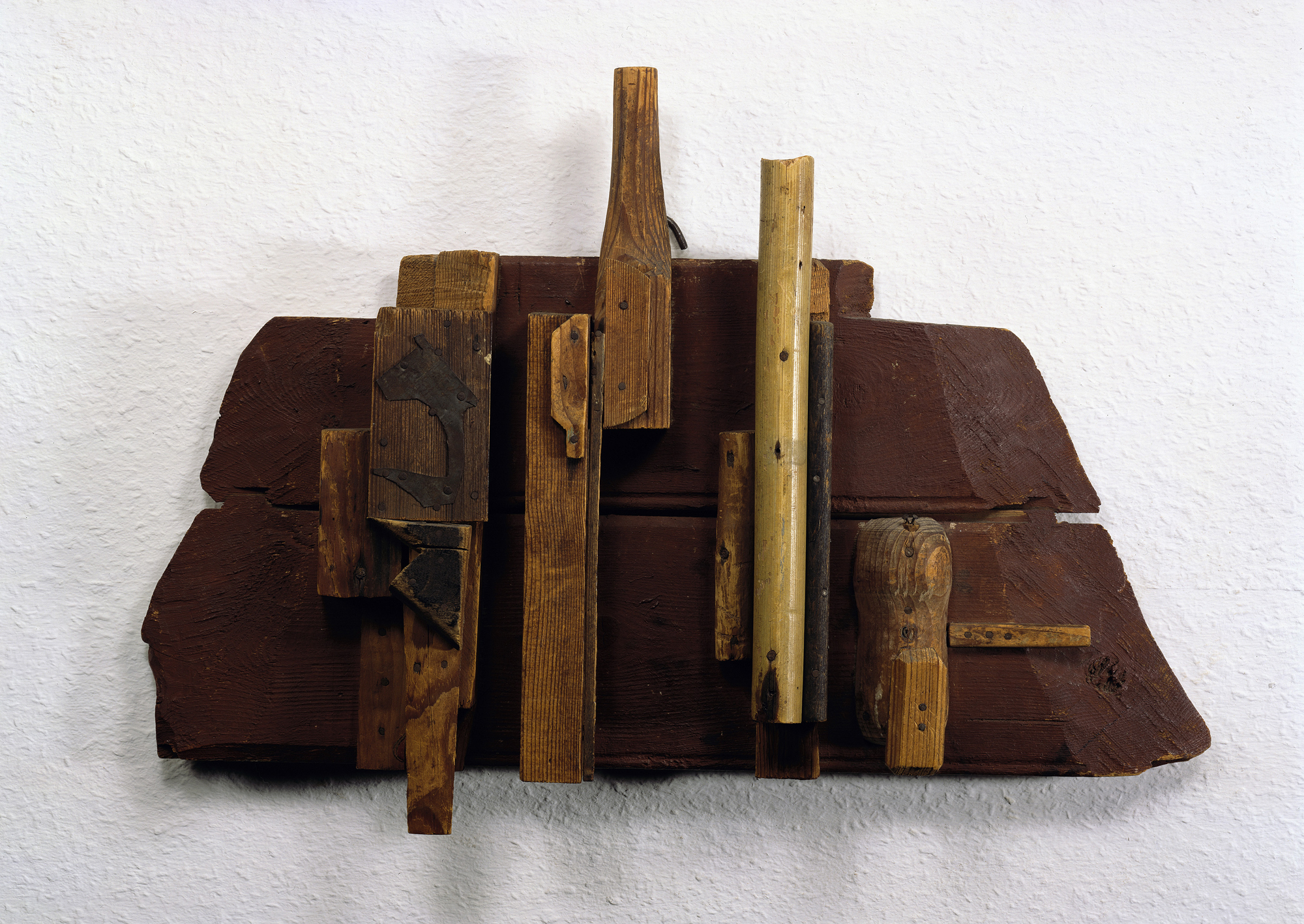Kurt Schwitters
The wide string, 1923
Artist
Kurt Schwitters
Title
The broad cord
Year of creation
1923
Technique and dimensions
Wood, assembled, fitted, painted, 36 x 56 x 12 cm
Year of acquisition
1979
The two material montages Cathedral and The Wide String were probably created in 1923 during a holiday on the Baltic Sea. In 1946 Schwitters remembered: “In 1923 I spent two weeks with Arp and Hannah Höch in Sellin, where I created a poem with Arp. We also took pictures with pieces of driftwood from the sea.” They probably already became the property of Hannah Höch, with whom he had a particularly friendly relationship.
“Schwitters and I,” as she later described their relationship, “both had the inclination to smuggle a little bit of romance into the world around us that had become so pragmatic. That's why we went on adventures." Their adventures are traveling together, climbing mountains and rocks, hiking, collecting flotsam and jetsam at the sea and from "country estates" in the big cities, Berlin, Dresden, Prague, The Hague. (Ernst Nündel, 1981). In a studio photo that was taken before 1925, during a visit by Theo and Nelly van Doesburg to the Berlin artist, both Arp's Concrete Relief and Schwitters's Wide String can be seen.
These two works are among the few material reliefs that have survived from this period and that, due to their obvious direct implementation on site, make the Dada artist's intentions particularly clear. Both are assembled exclusively from found remnants of objects and have almost no color, which is not very common with Schwitters. Here he relies entirely on the succinct intrinsic value of simple pieces of wood that he picked up on the beach and processed into his own compositions.
“Merz painting,” was one of his mottos, “does not only use paint and canvas, the brush, the palette, but all materials that can be perceived by the eye and all the necessary tools. It is irrelevant whether the materials used were already formed for some purpose or not. The stroller wheel, the wire net, the twine and the cotton are factors equal to the color. The artist creates through the choice, distribution and demoulding of materials.” This attitude also extends to assemblages and sculptures.
The inspiration for finding form - for example for The Wide Cord or the Cathedral - comes from the material remains of previously intact everyday objects and the design forces contained in them, which now - largely freed from any functionality - develop a kind of life of their own. The MERZ artist Schwitters, who is particularly receptive to such impulses and is “full of figure on the inside”, recognizes their often ignored elementary aesthetic effect and at the same time knows about the provocative alienation that is associated with the re-use of such “unartistic” material.
Even high culture The finding of form that is unique to Schwitters' works cannot ignore the fact that two completely opposite worlds meet and merge here without being able to eliminate their different origins: the rustic triviality of the everyday encounters the free, spiritual clarity In doing so, Schwitters not only opens the boundaries of a traditional concept of art, but at the same time raises awareness of the often under-perceived structures and material properties of the world of objects that surround us, precisely because he - in a sense a late romantic - sees the fragmented things that are already subject to transience to new function and symbolic power.
This conflict between tangible friction of reality and the creation of abstract symbols - in his case often overshadowed by the desire for playfulness, chance and paradox - can also be felt in these two reliefs. Both prove to be well-balanced, rhythmically structured compositions that derive their slightly awkward tensions from the nuanced juxtaposition of vertically arranged rows. Even the grain of the wood is included in the dynamic interplay of emerging forces against the background of a calmly spread out base area, which, like a soundboard, accommodates the angular, slightly rounded or sanded shapes and provides some support for them to project into the room. Despite all its integration, Schwitters' world of forms is always filled with a strong inner dynamic that seeks to reach into the limitless. In this way, the apparent harmony signaled by the parallelism of the individual parts is broken by disturbances and the overall structure is transformed into a conflict-like tension that works towards the center, as it were. The combination of object relics, which seems so simple, takes on the character of a thoroughly differentiated parable of real constellations: The broad string is reminiscent of a (figurative) grouping with individual moments. Similarities, equations and differences, but also superpositions and subordinations convey the image of diverse relationships between interconnected parts. In the cathedral, on the other hand, the tension between down-to-earthness and spiritualization, between burdensome and evaporating form, is placed in an extremely fragile relationship.
Kurt Schwitters is guided by a different intention in his object sculptures such as the Small Column, because there the constructive moment gains dominance. But not only the need for self-guaranteed stability, but also Schwitters' general passion for building, which pervades his entire work, is particularly clear in the sculptures. His work as a workshop draftsman at the Wülfel ironworks and his one-year architecture studies at the Hanover University of Technology also provide evidence of such ambitions. Ultimately, Schwitters always worked as a designer, but as someone who drew his “building blocks” from the dismantling of the functional in order to transform them into a poetic, liberated “construction”. The Small Column is therefore something of a homage to the tectonic and to the idea of building itself.
Fritz Jacobi
